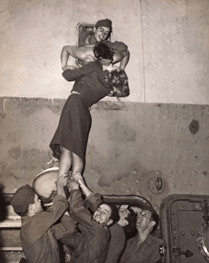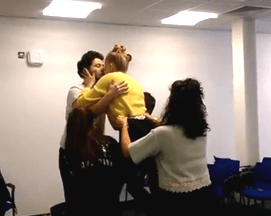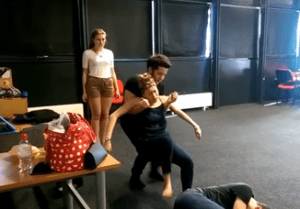As the public performance of When You See It draws nearer, our scenes are really beginning to take shape. Laura has recently provided Refract’s actors with the show’s running order which has given a much needed ascending structure to our fragmented and through-line scenes which they previously lacked. Mindful of our declaration that ‘Refract is storytelling’ (Refract, 2015), fictional linearity throughout the show is crucial.
The finalised running order has enabled me to fully comprehend the sentimentality of Billy and Dolly’s through-line story. Before the structure was embedded, I struggled to sympathise with Dolly’s infatuation, and eternal but problematical relationship, with Billy. I can now fully appreciate her emotional life journey throughout the performance and focus on making her story a convincing one.


Another complication with Billy and Dolly’s scenes has been staging their relationship. Because the production chiefly engages physical theatre to depict narrative, a performance style that ‘emphasises the actor’s body, rather than their words or their mind’ (Pavis, 2013, 181), and one I have little experience of, I initially found it difficult to convey an emotional connection with Billy. Bereft of speech, Tom and myself explored alternative means of creating a believable story including symmetrical, timed movements and close body contact. Once these had been practiced and perfected, the scenes instantly conveyed emotional intensity on a personal scale as intended by Laura.

Establishing the running order has also helped clarify my costume plans. Before the scenes were ordered it was difficult to determine what costume I needed for each section of the production. I have now been able to create a series of documents which, for example, records, scene by scene, which performer needs which costume, costume positions on stage and where they re-locate to. These were trialled in our tech and, apart from minor adjustments, were deemed successful.
Now that When You See It has a clear structure for myself as a performer and ready in terms of costume preparation, I can hardly wait to stage this brilliant and multifariously emotional production.
Works Cited:
Lancashire, A. (2015).
Memorable Kisses Throughout History (2015) [photograph] Available from: http://www.slideshare.net/guimera/memorable-kisses-throughout-history [Accessed 7 May].
Pavis, P. (2013) Contemporary Mise en Scène: Staging Theatre Today. London: Routledge.
Refract Theatre Company (2015) Manifesto. [online] Available from https://refracttheatrecompany.blogs.lincoln.ac.uk/our-manifesto [Accessed 7 May 2015].





